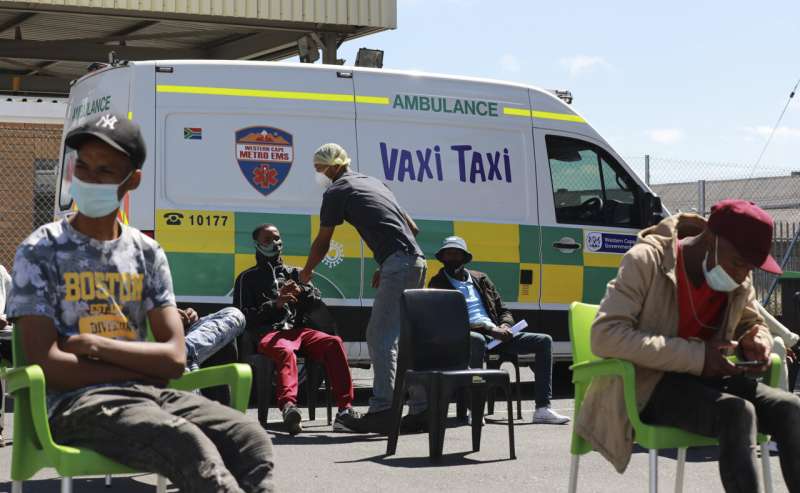
The omicron variant is offering more hints about what it may have in store as it spreads around the globe: A highly transmissible virus that may cause less severe disease, and one that can be slowed—but not stopped—by today’s vaccines.
An analysis Tuesday of data from South Africa, where the new variant is driving a surge in infections, suggests the Pfizer vaccine offers less defense against infection from omicron and reduced, but still good, protection from hospitalization.
The findings are preliminary and have not been peer-reviewed—the gold standard in scientific research—but they line up with other early data about omicron’s behavior, including that it seems to be more easily spread from person to person.
Still, some experts cautioned that it’s too soon to draw conclusions since the variant is still quite new and hospitalizations can lag weeks behind infections.
When omicron reaches broader populations more useful information will emerge, said Dr. David Dowdy, an infectious disease epidemiologist at Johns Hopkins Bloomberg School of Public Health.
“To date, omicron has disproportionately infected young adults—people who probably have more social contacts and are more likely to attend large gatherings,” Dowdy said. Young adults may be more likely to be sick without knowing it, have more intense exposures and experience milder disease, he said.
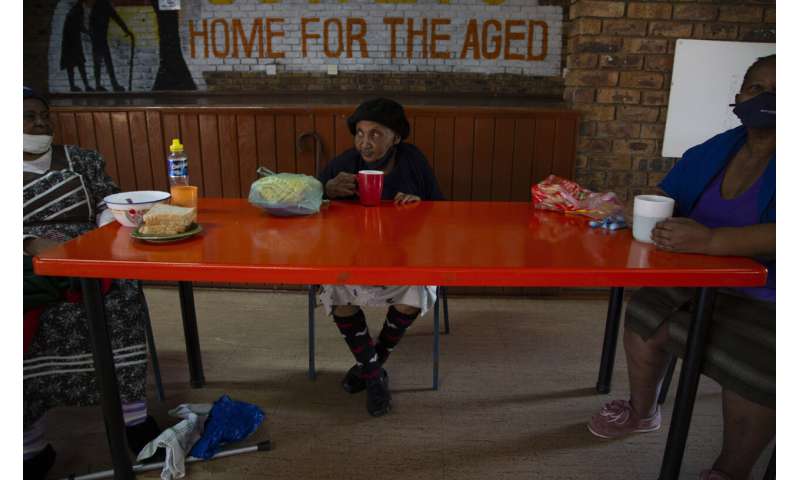
“At the end of the day, our society needs to learn how to wait, rather than either panicking or dismissing early findings,” Dowdy said.
U.S. health officials estimate that a small, but growing proportion of new COVID-19 infections are due to omicron, and that the rise is particularly dramatic in some places.
Two weeks ago, omicron accounted for less than 0.5% of the coronaviruses that were genetically sequenced in the U.S. That rose to about 3% last week, the Centers for Disease Control and Prevention reported Tuesday.
But it varies from place to place, and is as high as 13% in the New York/New Jersey area, according to the agency.
The CDC is tracking how fast the percentage doubles, and as more cases come in, may be better able to predict whether—or when—the omicron variant becomes the dominant version of the coronavirus in the U.S, health officials say.
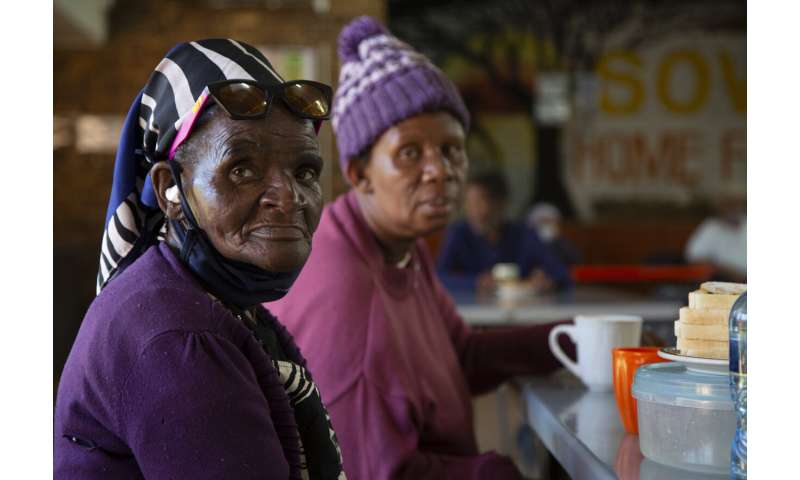
In Britain, omicron cases are doubling every two to three days. Health officials say the variant will replace delta as the dominant coronavirus strain within days.
In the new South Africa findings, people who received two doses of the Pfizer-BioNTech vaccine appeared to have just 33% protection against infection, compared to those who were unvaccinated, during the country’s current omicron-fueled surge, but 70% protection against hospitalization. The analysis was conducted by Discovery Health, South Africa’s largest private health insurer, and the South African Medical Research Council.
The study did not look at booster shots, which are not yet prevalent in South Africa but which data from elsewhere has indicated improves protection.
The Pfizer vaccine’s 70% protection against hospital admission during the omicron surge compares to a 93% protection level seen in South Africa’s delta-driven wave, according to the new analysis.
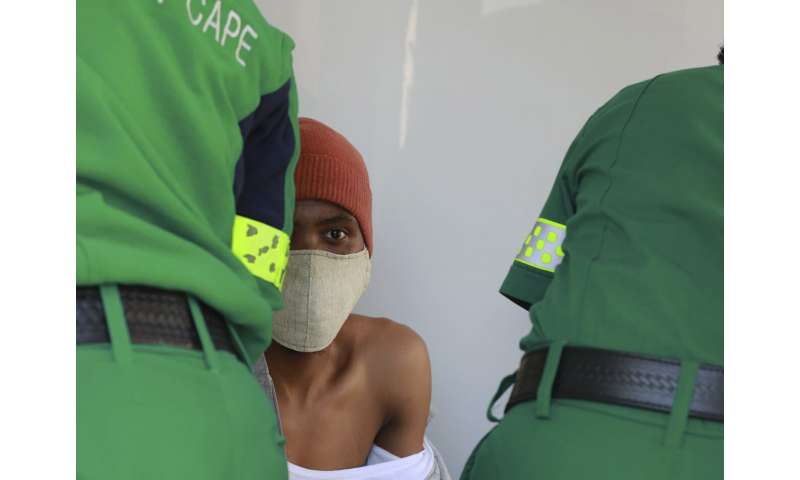
That’s a big drop in vaccine protection from severe illness requiring hospitalization, said Dr. Eric Topol, head of the Scripps Research Translational Institute.
“What we don’t know yet is whether the booster will restore that back to greater than 90% and for how long,” Topol said.
The analysis in South Africa was based on examining more than 211,000 COVID-19 test results that date from Sept. 1 to Dec. 7—41% of which were for adults who had received two doses of the Pfizer vaccine, which is the most commonly used one in South Africa.
Experts now say that omicron accounts for more than 90% of all new infections in South Africa, according to Discovery Health chief executive Dr. Ryan Noach.
Researchers around the world are rushing to figure out what the variant will mean for the coronavirus pandemic, now well into its second year. More information came Tuesday from Pfizer, which announced that its experimental pill to treat COVID-19—separate from it its vaccine—appears effective against omicron.
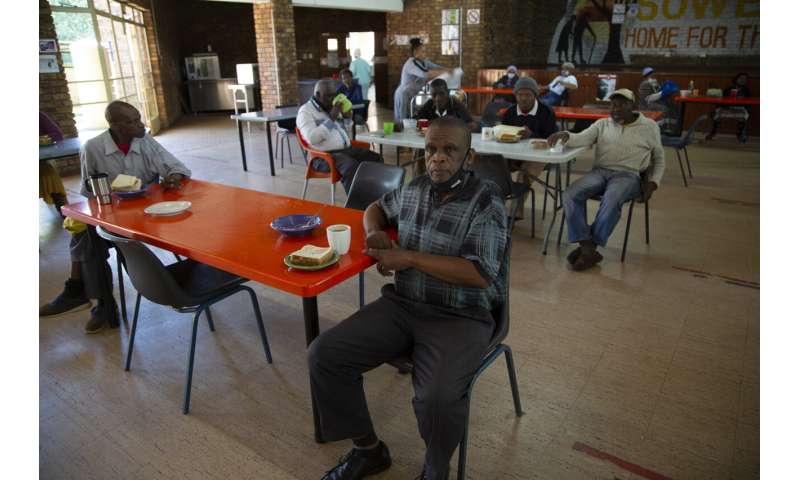
In the weeks since the variant was detected, South Africa has experienced rapid spread of the virus. The seven-day rolling average of daily new cases in the country rose over the past two weeks from 8.07 new cases per 100,000 people on Nov. 29 to 34.37 new cases per 100,000 people on Dec. 13, according to Johns Hopkins University. The death rate hasn’t increased during that same period.
Although case numbers are rising, hospital admissions for adults diagnosed with COVID-19 are 29% lower compared to the wave that South Africa experienced in mid-2020, after adjusting for vaccination status, according to the analysis.
But some say there’s still not enough data to draw broad conclusions about hospitalizations and the severity of disease caused by omicron.
“Their analyses covers just three weeks of data. Thus, it is important to avoid inferring too much right now,” Dr. Michael Head, Senior Research Fellow in Global Health, University of Southampton, wrote of the study.
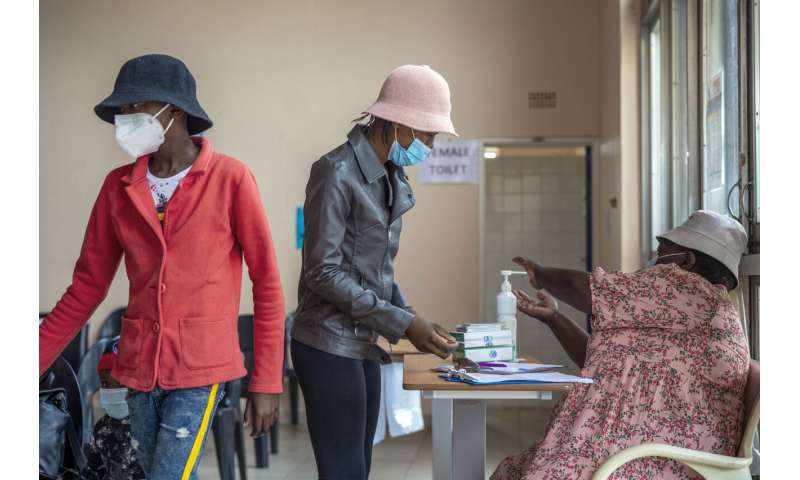 People register for COVID-19 vaccination at Soweto’s Baragwanath hospital, South Africa, Monday Dec. 13, 2021. South Africa’s 7-day rolling average of daily new COVID-19 cases has risen over the past two weeks from 7.60 new cases per 100,000 people on Nov. 28 to 32.71 new cases per 100,000 people on Dec. 12, according to Johns Hopkins University. In general, the new omicron cases have resulted in milder cases, with fewer hospitalizations and less severe cases requiring oxygen or intensive care. Credit: AP Photo/Jerome Delay
People register for COVID-19 vaccination at Soweto’s Baragwanath hospital, South Africa, Monday Dec. 13, 2021. South Africa’s 7-day rolling average of daily new COVID-19 cases has risen over the past two weeks from 7.60 new cases per 100,000 people on Nov. 28 to 32.71 new cases per 100,000 people on Dec. 12, according to Johns Hopkins University. In general, the new omicron cases have resulted in milder cases, with fewer hospitalizations and less severe cases requiring oxygen or intensive care. Credit: AP Photo/Jerome Delay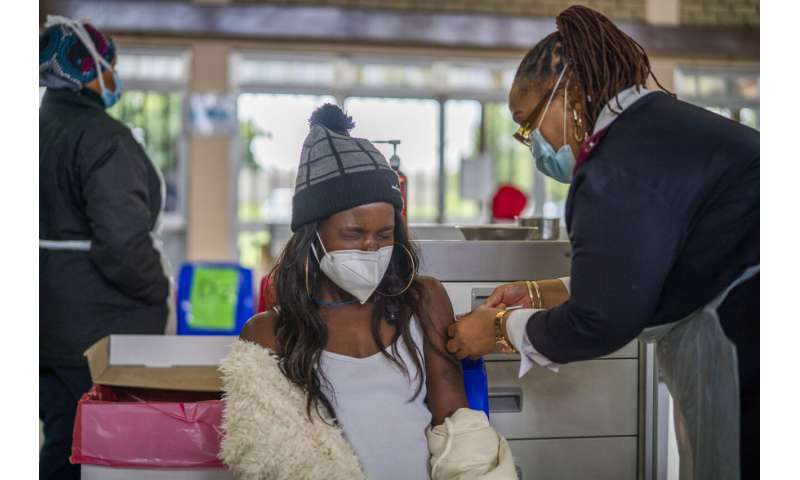 Takalane Mulaudzi, 29, grimaces as she gets her COVID-19 vaccination at Soweto’s Baragwanath hospital Monday Dec.13, 2021. Despite having adequate supplies of more than 19 million vaccine doses, South Africa’s vaccination campaign has lagged. Around 38 percent of the adult population in South Africa has been vaccinated. The relatively slow rate of vaccinations makes the government’s goal of inoculating 67% of the population by February 2022 look unrealistic.Credit: AP Photo/Jerome Delay
Takalane Mulaudzi, 29, grimaces as she gets her COVID-19 vaccination at Soweto’s Baragwanath hospital Monday Dec.13, 2021. Despite having adequate supplies of more than 19 million vaccine doses, South Africa’s vaccination campaign has lagged. Around 38 percent of the adult population in South Africa has been vaccinated. The relatively slow rate of vaccinations makes the government’s goal of inoculating 67% of the population by February 2022 look unrealistic.Credit: AP Photo/Jerome Delay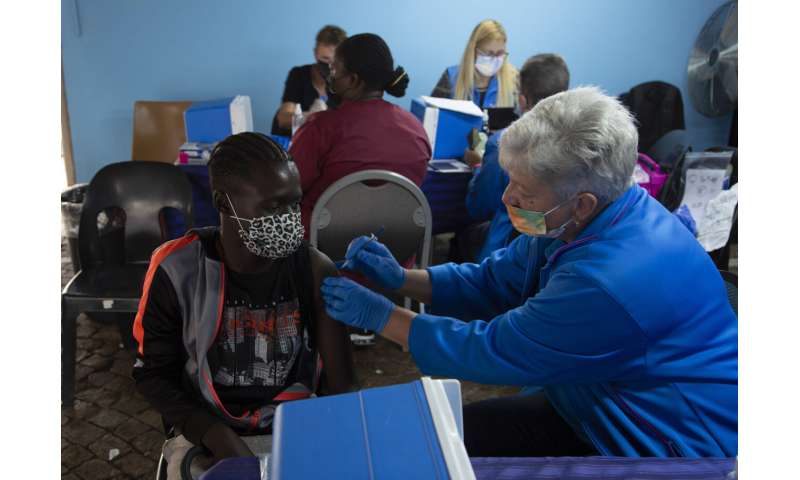 A man gets vaccinated against COVID-19 at a site near Johannesburg, Monday, Dec. 13, 2021 a day after South African President Cyril Ramaphosa tested positive receiving for mild COVID-19 symptoms after testing positive for the disease. Ramaphosa started feeling unwell Sunday and a test confirmed COVID-19. A statement said he has mild symptoms, is self-isolating in Cape Town and is being monitored by the South African Military Health Service. Credit: AP Photo/Denis Farrell
A man gets vaccinated against COVID-19 at a site near Johannesburg, Monday, Dec. 13, 2021 a day after South African President Cyril Ramaphosa tested positive receiving for mild COVID-19 symptoms after testing positive for the disease. Ramaphosa started feeling unwell Sunday and a test confirmed COVID-19. A statement said he has mild symptoms, is self-isolating in Cape Town and is being monitored by the South African Military Health Service. Credit: AP Photo/Denis Farrell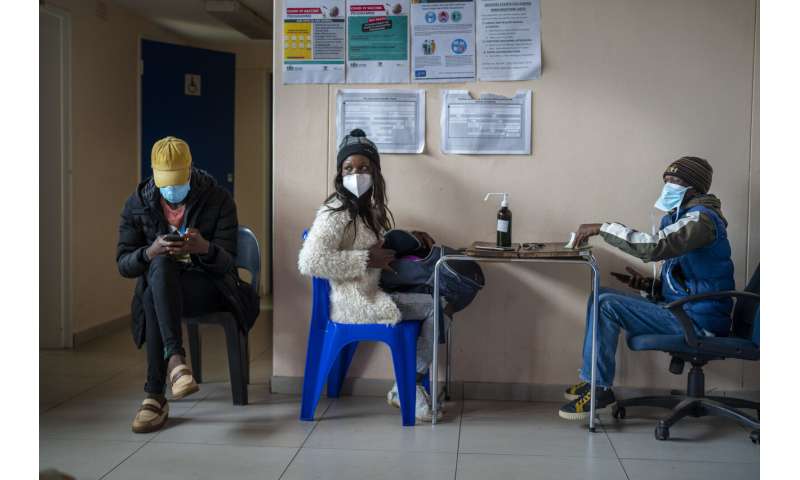 Takalane Mulaudzi, 29, is processed before getting her COVID-19 vaccination at Soweto’s Baragwanath hospital Monday Dec.13, 2021. Despite having adequate supplies of more than 19 million vaccine doses, South Africa’s vaccination campaign has lagged. Around 38 percent of the adult population in South Africa has been vaccinated. The relatively slow rate of vaccinations makes the government’s goal of inoculating 67% of the population by February 2022 look unrealistic. Credit: AP Photo/Jerome Delay
Takalane Mulaudzi, 29, is processed before getting her COVID-19 vaccination at Soweto’s Baragwanath hospital Monday Dec.13, 2021. Despite having adequate supplies of more than 19 million vaccine doses, South Africa’s vaccination campaign has lagged. Around 38 percent of the adult population in South Africa has been vaccinated. The relatively slow rate of vaccinations makes the government’s goal of inoculating 67% of the population by February 2022 look unrealistic. Credit: AP Photo/Jerome Delay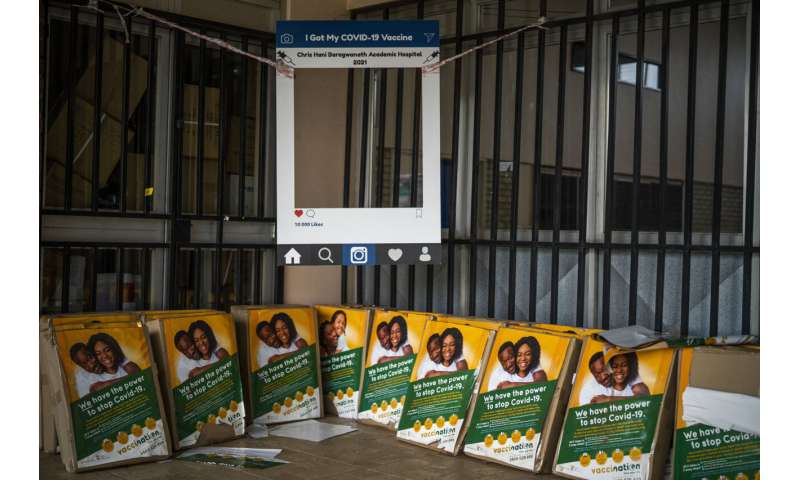 Vaccine literature is displayed at a COVID-19 vaccination center at Soweto’s Baragwanath hospital Monday Dec.13, 2021. Despite having adequate supplies of more than 19 million vaccine doses, South Africa’s vaccination campaign has lagged. Around 38 percent of the adult population in South Africa has been vaccinated. The relatively slow rate of vaccinations makes the government’s goal of inoculating 67% of the population by February 2022 look unrealistic.Credit: AP Photo/Jerome Delay
Vaccine literature is displayed at a COVID-19 vaccination center at Soweto’s Baragwanath hospital Monday Dec.13, 2021. Despite having adequate supplies of more than 19 million vaccine doses, South Africa’s vaccination campaign has lagged. Around 38 percent of the adult population in South Africa has been vaccinated. The relatively slow rate of vaccinations makes the government’s goal of inoculating 67% of the population by February 2022 look unrealistic.Credit: AP Photo/Jerome Delay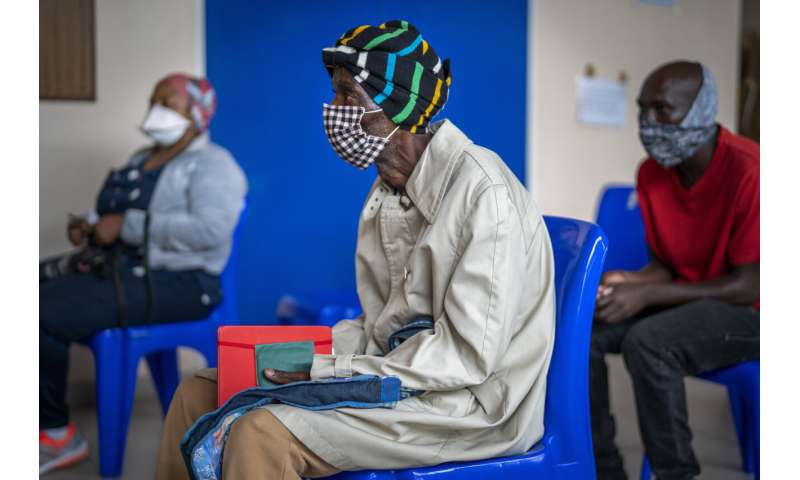 People wait for COVID-19 vaccination at Soweto’s Baragwanath hospital Monday Dec. 13, 2021. South Africa’s 7-day rolling average of daily new COVID-19 cases has risen over the past two weeks from 7.60 new cases per 100,000 people on Nov. 28 to 32.71 new cases per 100,000 people on Dec. 12, according to Johns Hopkins University. In general, the new omicron cases have resulted in milder cases, with fewer hospitalizations and less severe cases requiring oxygen or intensive care. Credit: AP Photo/Jerome Delay
People wait for COVID-19 vaccination at Soweto’s Baragwanath hospital Monday Dec. 13, 2021. South Africa’s 7-day rolling average of daily new COVID-19 cases has risen over the past two weeks from 7.60 new cases per 100,000 people on Nov. 28 to 32.71 new cases per 100,000 people on Dec. 12, according to Johns Hopkins University. In general, the new omicron cases have resulted in milder cases, with fewer hospitalizations and less severe cases requiring oxygen or intensive care. Credit: AP Photo/Jerome Delay People register for COVID-19 vaccination at Soweto’s Baragwanath hospital, South Africa, Monday Dec. 13, 2021. South Africa’s 7-day rolling average of daily new COVID-19 cases has risen over the past two weeks from 7.60 new cases per 100,000 people on Nov. 28 to 32.71 new cases per 100,000 people on Dec. 12, according to Johns Hopkins University. In general, the new omicron cases have resulted in milder cases, with fewer hospitalizations and less severe cases requiring oxygen or intensive care. Credit: AP Photo/Jerome Delay
People register for COVID-19 vaccination at Soweto’s Baragwanath hospital, South Africa, Monday Dec. 13, 2021. South Africa’s 7-day rolling average of daily new COVID-19 cases has risen over the past two weeks from 7.60 new cases per 100,000 people on Nov. 28 to 32.71 new cases per 100,000 people on Dec. 12, according to Johns Hopkins University. In general, the new omicron cases have resulted in milder cases, with fewer hospitalizations and less severe cases requiring oxygen or intensive care. Credit: AP Photo/Jerome Delay Takalane Mulaudzi, 29, grimaces as she gets her COVID-19 vaccination at Soweto’s Baragwanath hospital Monday Dec.13, 2021. Despite having adequate supplies of more than 19 million vaccine doses, South Africa’s vaccination campaign has lagged. Around 38 percent of the adult population in South Africa has been vaccinated. The relatively slow rate of vaccinations makes the government’s goal of inoculating 67% of the population by February 2022 look unrealistic.Credit: AP Photo/Jerome Delay
Takalane Mulaudzi, 29, grimaces as she gets her COVID-19 vaccination at Soweto’s Baragwanath hospital Monday Dec.13, 2021. Despite having adequate supplies of more than 19 million vaccine doses, South Africa’s vaccination campaign has lagged. Around 38 percent of the adult population in South Africa has been vaccinated. The relatively slow rate of vaccinations makes the government’s goal of inoculating 67% of the population by February 2022 look unrealistic.Credit: AP Photo/Jerome Delay
“Is omicron milder, or more severe than delta?” asked Head. “Time will tell. The world’s finest scientists, including many in the global south such as in South Africa, will find out. For now, national-level decision-makers have to consider that discretion is the better part of valor.”
This story has been updated to correct the time period that the samples were from. They dated from Sept. 1 to Dec. 7, not Nov. 15 to Dec. 7. It also corrects that not all of the samples were positive, as a news release from Discovery initially said.
Andrew Meldrum

